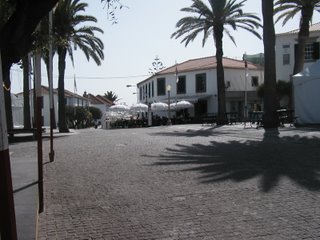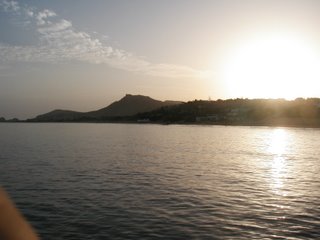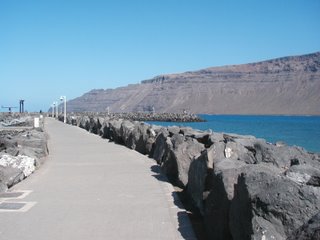 This is the town square in Vila Baleira, Porto Santo, Madeira - on this Sunday, only some of the cafes were open, and there were few people around until later in the day when they drifted up from the beach. It was also the free wi-fi zone, shared by inhabitants and visitors alike to reach the rest of the world.
This is the town square in Vila Baleira, Porto Santo, Madeira - on this Sunday, only some of the cafes were open, and there were few people around until later in the day when they drifted up from the beach. It was also the free wi-fi zone, shared by inhabitants and visitors alike to reach the rest of the world.
Looking along the beach on the south coast of Porto Santo from Vila Baleira toward the harbour of Porto Santo where we anchored. It was late in the day - earlier the beach was full of people sunbathing, swimming and playing.
 The sun is setting over the island of Porto Santo in a bright silver haze after a hot day.
The sun is setting over the island of Porto Santo in a bright silver haze after a hot day. From the breakwater of the Marina on Graciosa you can look across the narrow gulf toward the much larger island of Lanzarote. The slopes you see changed colour and definition constantly, from muted grey to warm gold, from misty shapes to sharply defined slopes and chasms.
From the breakwater of the Marina on Graciosa you can look across the narrow gulf toward the much larger island of Lanzarote. The slopes you see changed colour and definition constantly, from muted grey to warm gold, from misty shapes to sharply defined slopes and chasms. A different mood: the sun is setting on a cloudy evening over the anchorage at Playa Francesa.
A different mood: the sun is setting on a cloudy evening over the anchorage at Playa Francesa. This house down toward the eastern end of the village of Caleta del Sebo actually had a lot of greenery around it - the cactus to the right was also sporting a groom, mop, and sundry other bits of cleaning equipment whenwe passed.
This house down toward the eastern end of the village of Caleta del Sebo actually had a lot of greenery around it - the cactus to the right was also sporting a groom, mop, and sundry other bits of cleaning equipment whenwe passed. The coast of Lanzarote travelling west from Graciosa, with its volcanic cones and lava plains and its sand blown in from the Sahara. The light in this whole area is constantly changing, as the haze of sand and dust grows less or more and the clouds and spray and morning mist come and go.
The coast of Lanzarote travelling west from Graciosa, with its volcanic cones and lava plains and its sand blown in from the Sahara. The light in this whole area is constantly changing, as the haze of sand and dust grows less or more and the clouds and spray and morning mist come and go.At the beginning of September we left Praia da Vitoria on Terceira for Porto Santo, the smaller island off Madeira. We enjoyed a couple of day with good winds, which dropped on our third day out. For the next three days we had light winds and slow sailing, days in which we meandered along covering between forty-five and seventy miles a day. Then the winds picked up and we moved briskly along again, arriving in Porto Santo seven days and about seven hundred miles later.
Having arrived there we would have liked to stay longer in Porto Santo, and to have visited Funchal on the main island of Madeira, but were discouraged by a change in policy which saw sailboats anchored outside the harbours being charged commercial rates for the time they spent there. Some people we spoke to about this opted not to visit Madeira at all; others who found out about it while they were there refused to pay - those in the most difficult position were boats which had anchored out while waiting for daylight to enter a harbour, and were told about the charges only after they were in a marina.
Government policies and their effects aside, Porto Santo itself was a pleasant place to visit. We anchored in the inner harbour for a relatively small charge, and found the people we dealt with friendly , polite and quick to help. From the harbour we bicycled in to the town of Vila Baleira where we were able to pick up supplies and take advantage of the free wi-fi which we found in the town centre. Several afternoons found us sitting with our computer on one of the stone ledges surrounding the town square, along with other visitors and some of the local young people - while we picked up e-mail and checked weather, others were listening to music and chatting. An interesting example of the way the long arm of the internet reaches more and more places now.
We liked what we saw of Vila Baleira, which is an attractive town fronted by a long and beautiful beach which literally stretches for miles, the beach being the main attraction for many of the visitors who come to the town by plane or boat or ferry. On the Sunday we were there we found the beach filled with visitors and locals alike - then it suddenly emptied in the late afternoon and we noticed that many of the people from the beach made their way to an ice cream booth in the town square which did a couple of hours of brisk business. Though our stay was short, the day we left we managed to fit in a visit to the Christopher Columbus Museum - there are several scattered through the Azores and Canaries in places where he is known to have stopped. We enjoyed the way the exhibit placed Columbus’ stay in Porto Santo in the context of the marine history of the times as well as the history of the island. Though the exhibits were presented and explained in Portuguese there were translation sheets in every room for those of us who speak English - a great help.
We stayed three nights and four days in Porto Santo and left on a windy evening with the gusts funnelling down off the mountains. The wind was with us all the way to Graciosa, the most north easterly inhabited island of and our first stop in the Canaries. We had a fast, hard sail getting there, covering the two hundred and ninety miles in less than two and a half days and spending several hours with the boat hove to off the coast waiting for daylight before we entered the harbour. The sun rose to show us the island of Graciosa on one side of the channel and the towering cliffs of Lanzarote on the other, a landscape we have been enjoying ever since.
Our first couple of days in Graciosa were spent sleeping; in between we managed to find the supermarkets - the restaurants and bars were easy to see. On our fourth day here we moved out of the marina and anchored off a beach about forty-five minutes walk from the village, Playa Francesa. And there we stayed with the days just drifting past, finding it very easy in this setting to relax and slow down. We did some boat work, repairing and maintaining; walked into town for supplies every three or four days; and swam off the boat most days, enjoying the clear water and clean conditions. When we first got to the anchorage there were only five other boats there, but over time the number grew until, at the maximum, we had about twenty boats there, large and small. Most were European - French, Dutch, German, Norwegian, Swedish, English, Spanish - though we did meet the crew of one American boat and of a couple of boats from Australia, and glimpsed a Canadian boat which changed its mind on its way into the anchorage and headed for the marina.
A few mornings we were able to watch small local fishing boats at work close by - they are well maintained and colourful, and the men on them travel around the area they are working in and look for fish before they set out their nets. They look the old fashioned way - standing on the bow of the boat looking into the water, or using glass-bottomed box-like instruments to see below the surface. Considering how difficult fish can be to see against the bottom, it must take a combination of sharp eyes and experience to be good at finding them - but then fishing has been a way of life here for a long time.
You wonder if they notice the beauty of the landscape they are working and living in. You also wonder about the kinds of conditions which have lead to the building of the thick-walled white painted houses with their small shuttered windows that people live in in the village. Partly it must be because the original houses were constructed with the material most available here - volcanic rocks, which were piled into thick, sometimes curving walls for the houses and sometimes the property around them. Building on such sandy soil must also have had an impact on the design - but so far we have not been able to learn much about such things. Perhaps in the future.
One fascinating thing we have noticed here is that the light changes all the time, and with it the colour and textures of the landscape. Lanzarote’s cliffs can be steely grey in the morning, washed out brown at midday, and full of detail and colour in the evening. The coast of Lanzarote falls away to the west in a series of plains and volcanic cones, sometimes looking soft and misty and at others standing out starkly beautiful. The dunes on Graciosa change colour in the light too, from almost white to golden yellow, the vegetation on them sometimes dry brown, sometimes green interlaced with brown and black. The clouds come over the cliffs of Lanzarote - indeed they are there most mornings - and soften the starkness of their outlines. Perhaps not a place which is beautiful in the conventional way, but beautiful all the same.
We will stay here a while longer, and explore the island more before we move on to Lanzarote and the work of the architect/artist Cesar Manrique.